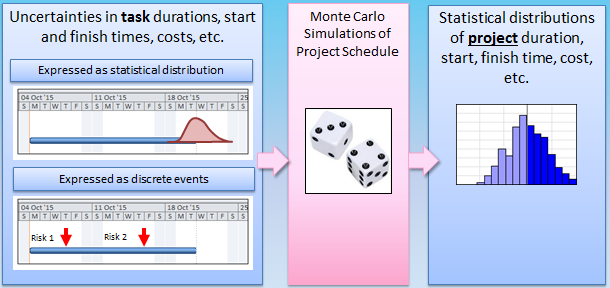What is Schedule Risk Analysis?
Schedule risk analysis (SRA) is a method of analysis of uncertainties in project schedules. The input uncertainties are related to task duration, start and finish times, lags, and other parameters. The results on analysis include uncertainties in project duration, start and finish time, and other project schedule parameters. Schedule risk analysis helps to determine what the chance is that the current project will meet specific milestones or other schedule objectives. Schedule risk analysis also includes sensitivity analysis. Results of schedule risk analysis show how project parameters, such as project duration, start and finish times, are sensitive to uncertainties in task duration, start and finish times, and other parameters.
There are a number of statistical methods that can be used to perform schedule risk analysis; however, the most common, accurate and easy to use method are Monte Carlo simulations. During a schedule risk analysis process using Monte Carlo simulations, the schedule is calculated multiple times using Critical Path Method (CPM). Although schedule risk involves creating a statistical model, schedule risk analysis doesn’t have to be complicated. RiskyProject software offers an easy way to accurately measure the effects of risk events and uncertainties on your project schedule.
Schedule Risk Analysis vs. Cost Risk Analysis
Many project schedules contain both schedule and cost information. Cost information can be defined as fixed cost and variable cost. If a project schedule has resources assigned to tasks and these resources include rates, variable costs will be calculated. Schedule risk analysis and cost risk analysis can be conducted at the same time during the same run of Monte Carlo simulations. Therefore, frequently the term schedule risk analysis implies that a cost risk analysis will be also conducted.
The results of cost risk analysis is a statistical distribution of project cost. Cost risk analysis helps to determine what is the chance that project will be complete on budget. Sensitivity analysis helps to determine what tasks or resources have the greatest potential effect on project cost.
Uncertainties for Schedule Risk Analysis
Uncertainties for schedule risk analysis can be expressed two ways:
- Using statistical distributions of task duration, cost, start time and other parameters
- Using discrete events, often referred to as risks or risk drivers.
The first method requires users to define a statistical distributions (in most cases using three point estimates: low, base, and high of task duration, cost, start time, etc.). In most cases, users create the estimates based on their own experience with similar activities. However, this method is dependent upon the user’s ability to recall all relevant activities or inability to account for all factors which may increase or decrease the duration, cost or other parameter.
The second method has been proven to be more accurate, because it accounts for and uses the underlying causes for task delays and cost increases. For example, task durations can be increased due to an event “change of requirements” “bad weather” with probability 20%, each which have a probability of occurrence and impacts on cost or duration. These events can be part of risk register. Then these events can be assigned to different tasks or resources. Using risk events will normally provide a much better foundation for risk management as the results of the Monte Carlo simulations will automatically identify critical risks or events that have the most potential to affect the project cost and schedule objectives.
Monte Carlo simulations run the same way for both methods of defining uncertainties and there is no difference in the calculation performance. Ideally, the most effective way to determine how much cost and schedule risk your project has it to use a combination of both methods. Use risk events to model all important project risks and use three point estimates to account for other uncertainties, which are difficult to assess and can be assigned as a statistical distribution. For example, in addition to the aforementioned risks: “changing requirements” and “bad weather” there can be other less likely factors affecting task duration or cost. These factors or “noise” will be captures using the statistical distribution for task duration defined as three point estimates.

RiskyProject: Schedule Risk Analysis Software
RiskyProject will run a Monte Carlo schedule risk analysis on your project schedule using an integrated risk register and identified uncertainties to produce an easy to understand “risked” schedule. RiskyProject reports will quickly allow your team to determine if the current schedule is reasonable and highlight activities or risks that are the main sources of risk exposure.
RiskyProject integrated risk register accurately prioritizes risks and presents them in both pre and post-mitigated states. The risk register delivers a complete risk management capability that allows you to create mitigation plans and perform cost benefit analysis of your planned risk responses and quickly identify the most cost effective risk response plans.
To run a schedule analysis in RiskyProject:
- Import your schedule from Microsoft Project, Primavera, or other project scheduling software
- Assign risks from the integrated risk register to project activities with probability and schedule impacts
- Apply schedule uncertainties to project activities
- Run the simulation
- Easily generate Histograms or Cumulative Probability charts to determine the chance that you will meet specific schedule objectives
- Use the Sensitivity view (for the project) or Tornado Plot (for activities) to uncover the main drivers (risks or activities) of schedule variance in your project
To run a schedule analysis in Microsoft Project:
- Open your project in Microsoft Project
- Apply schedule uncertainties (low and high estimates) to activities using the RiskyProject Addin
- Click the Calculate button
- View the simulation results in the Project Information or use the Statistical Report to view probabilities and sensitivities for any activities in your schedule
- Easily generate Histograms or Cumulative Probability charts to determine the chance that you will meet specific schedule objectives
- Use the Sensitivity view (for the project) or Tornado Plot (for activities) to uncover the main drivers (risks or activities) of schedule variance in your project




